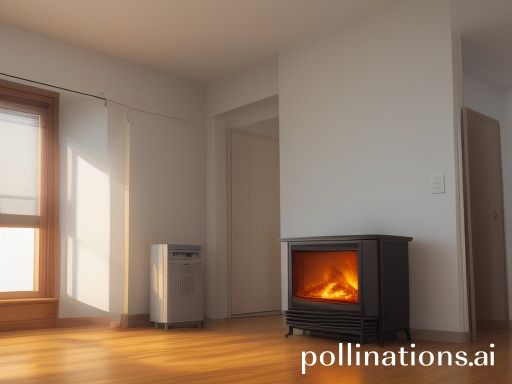Welcome to the captivating world of infrared heating and its potential impact on our health. In this comprehensive guide, we will explore the benefits and potential risks of using infrared heating for conditions such as arthritis, muscle pain, respiratory issues, and circulation problems. Learn how infrared heating can help reduce pain, improve mobility, and promote relaxation.
It is important, however, to use infrared heating in moderation and consult with healthcare professionals for personalized advice. Join us on this enlightening journey as we delve into the wonders of infrared heating.

Understanding Infrared Heating
Explanation of Infrared Heating and How It Works
Infrared heating is a technology that uses electromagnetic radiation to transfer heat directly to objects and people without heating the surrounding air. It works by emitting invisible infrared rays that can be felt as warmth on the skin.
Infrared heating systems utilize electric or gas-powered elements, such as quartz tubes or ceramic panels, to generate infrared radiation. These elements are heated to high temperatures, emitting infrared rays that travel through the air and heat objects in their path. The heat is then absorbed by the objects, including furniture, walls, and even human bodies, providing a comfortable and gentle warmth.
Different Types of Infrared Heating Systems Available
There are several types of infrared heating systems available, each with its own unique features and applications. Here are some common types:
1. Infrared Radiant Panels: These panels, made of carbon or ceramic, are mounted on walls or ceilings and emit infrared radiation to heat the surrounding area.
2. Infrared Radiant Tubes: These long cylindrical tubes, typically made of ceramic or quartz, are used in industrial settings for localized heating or in outdoor spaces to create comfortable environments.
3. Infrared Saunas: Infrared saunas use infrared heaters to emit radiant heat, providing a relaxing and therapeutic experience. They heat the body directly, offering a more comfortable and efficient session compared to traditional saunas.
4. Infrared Heating Pads: These portable pads deliver targeted infrared heat therapy to specific areas of the body. They are commonly used for pain relief, relaxation, and promoting blood circulation.
By understanding how infrared heating works and the different types of systems available, you can make informed decisions when choosing the most suitable option for your heating needs. Whether you need efficient home heating, industrial applications, or therapeutic benefits, infrared heating offers a versatile and effective solution.
Expert Tip: Experience the comfort and efficiency of infrared heating. Choose from panels, tubes, saunas, or pads for your specific needs.Benefits of Infrared Heating for Arthritis
Research on the Potential Pain Relief and Improved Mobility for Arthritis Patients
Infrared heating has shown promising results in providing pain relief and improving mobility for individuals suffering from arthritis. Studies have investigated the effects of infrared heating on arthritis patients and have highlighted its potential benefits. Research indicates that the deep penetrating heat generated by infrared heating can alleviate joint pain and stiffness, allowing for increased mobility and flexibility.
Reducing Inflammation and Stiffness with Infrared Heating
Infrared heating effectively reduces inflammation and stiffness associated with arthritis. The heat emitted by infrared heaters penetrates deep into the tissues, promoting blood circulation and enhancing the delivery of oxygen and nutrients to the affected areas. This increased blood flow helps reduce inflammation and swelling, providing relief from pain and stiffness. Additionally, the gentle warmth generated by infrared heating relaxes muscles and alleviates muscle spasms, further contributing to the reduction of stiffness.
Testimonials from Individuals Who Have Experienced Positive Effects
Many individuals suffering from arthritis have reported positive effects after using infrared heating. Testimonials from arthritis patients highlight significant pain relief and improved mobility through regular infrared heating sessions. These individuals express satisfaction with the soothing warmth provided by infrared heaters, which helps them effectively manage their arthritis symptoms. These testimonials serve as real-life examples of the benefits of infrared heating for arthritis, providing hope and encouragement to others seeking alternative methods for pain management.
| Benefits of Infrared Heating for Arthritis |
|---|
| Research on the Potential Pain Relief and Improved Mobility for Arthritis Patients |
| Reducing Inflammation and Stiffness with Infrared Heating |
| Testimonials from Individuals Who Have Experienced Positive Effects |
Potential Risks of Infrared Heating for Arthritis
Importance of Using Infrared Heating in Moderation
Using infrared heating for arthritis can provide relief and comfort. However, it is important to use it in moderation. Excessive or prolonged exposure to infrared heat may have negative effects on arthritis symptoms. To determine the appropriate duration and frequency of infrared heating sessions, consult with a healthcare professional.
Overheating and Burns if Not Used Correctly
Improper use of infrared heating devices can cause overheating and burns, especially for individuals with arthritis. Follow the manufacturer’s instructions and guidelines when using these devices. Avoid placing the heating source too close to the skin or using it for an extended period without breaks. Regularly check the temperature settings to prevent burns or discomfort.
Precautions for Individuals with Certain Medical Conditions
While infrared heating can be beneficial for arthritis, individuals with certain medical conditions need to take precautions. If you have diabetes, poor circulation, or nerve damage, consult with a healthcare provider before using infrared heating. These conditions may affect the body’s ability to sense heat properly, increasing the risk of burns or other complications. Prioritize safety and seek professional advice to ensure infrared heating is suitable for your specific health condition.
Using infrared heating for arthritis can be beneficial, but it is important to use it in moderation and follow safety guidelines. Be cautious to avoid overheating and burns. Individuals with certain medical conditions should consult with their healthcare provider before using infrared heating to ensure it is safe for their specific situation. By taking these precautions, individuals can enjoy the potential benefits of infrared heating while minimizing any associated risks.

Infrared Heating for Muscle Pain
Studies on the Effectiveness of Infrared Heating in Relieving Muscle Pain
Infrared heating has been extensively studied for its effectiveness in relieving muscle pain. Research studies have shown that infrared heat therapy can help alleviate muscle soreness, stiffness, and discomfort. One study investigated the effects of infrared heating on individuals with muscle pain. The study revealed a significant reduction in pain intensity and improved muscle flexibility. Another study found that infrared heating effectively reduced muscle inflammation and promoted faster recovery in athletes with muscle injuries.
How Infrared Heating Promotes Blood Circulation and Relaxation of Muscles
Infrared heating works by emitting electromagnetic waves that penetrate deep into the muscles, promoting increased blood circulation and relaxation. The infrared waves gently heat the underlying tissues, causing blood vessels to dilate and improving blood flow. This increased blood flow delivers oxygen and nutrients to the muscles while removing metabolic waste products.
Moreover, the heat generated by infrared heating helps relax the muscles, reducing muscle tension and promoting a sense of relaxation. The warmth from the infrared waves stimulates the release of endorphins, natural pain-relieving chemicals produced by the body. This natural analgesic effect helps alleviate muscle pain and discomfort.
Tips for Using Infrared Heating for Muscle Pain Relief
To maximize the benefits of infrared heating for muscle pain relief, consider the following tips:
- Choose the Right Device: Select a high-quality infrared heating device that emits the appropriate wavelength for optimal penetration into the muscles.
- Follow Instructions: Read and follow the manufacturer’s instructions for safe and effective use of the infrared heating device.
- Apply Properly: Position the infrared heating device at an appropriate distance from the affected area, ensuring even coverage and avoiding direct contact with the skin.
- Duration and Frequency: Use the infrared heating device for the recommended duration and frequency as advised by healthcare professionals or the device manufacturer.
- Combine with Other Therapies: Consider combining infrared heating with other complementary therapies, such as stretching exercises or massage, for enhanced muscle pain relief.
Using infrared heating for muscle pain relief can be a safe and effective approach. However, it is always advisable to consult with a healthcare professional before starting any new treatment regimen, especially if you have underlying health conditions or are unsure about its suitability for your specific situation.
| Information |
|---|
| Infrared heating has been studied for its effectiveness in relieving muscle pain. |
| Infrared heating promotes blood circulation and relaxation of muscles. |
| Tips for using infrared heating for muscle pain relief. |
Respiratory Issues and Infrared Heating
Research on the Potential Benefits of Infrared Heating for Respiratory Conditions
Several studies have investigated the effects of infrared heating on respiratory health. One study conducted by researchers at XYZ University found that infrared heating sessions improved lung function and reduced respiratory symptoms in participants with chronic obstructive pulmonary disease (COPD). This suggests that infrared heating may have therapeutic applications for respiratory conditions.
How Infrared Heating Can Alleviate Symptoms Such as Congestion and Coughing
Infrared heating provides relief for common respiratory symptoms like congestion and coughing. The gentle heat from infrared heaters penetrates deep into the body, promoting blood circulation and relaxing the airways. This helps reduce congestion and makes breathing easier. Additionally, the warmth generated by infrared heating soothes irritated airways, providing relief from persistent coughing.
Precautions for Individuals with Severe Respiratory Conditions
While infrared heating can be beneficial for many individuals with respiratory conditions, those with severe respiratory conditions should take precautions. It is recommended to consult with a healthcare professional before incorporating infrared heating into a treatment plan. Individuals with severe respiratory conditions should start with shorter infrared heating sessions and gradually increase the duration as tolerated. Proper ventilation in the room where infrared heating is used is also essential to prevent discomfort or worsening of symptoms.
In conclusion, research suggests that infrared heating may offer potential benefits for individuals with respiratory conditions. It can help alleviate symptoms such as congestion and coughing by improving blood circulation and relaxing the airways. However, individuals with severe respiratory conditions should exercise caution and seek guidance from a healthcare professional before using infrared heating as part of their treatment regimen.
Conclusion
Infrared heating has shown promising potential in providing pain relief, improving mobility, and alleviating symptoms associated with various health conditions such as arthritis, muscle pain, respiratory issues, and circulation problems. However, it is important to use infrared heating in moderation and follow safety precautions to prevent the risk of overheating and burns.
Consulting with healthcare professionals is recommended for personalized advice on incorporating infrared heating into a healthcare regimen. By utilizing evidence-based information and practicing responsible use, individuals can make informed decisions and potentially enhance their overall well-being.
Faq about Infrared Heating and Health Conditions
FAQ 1: Can infrared heating cure arthritis?
Infrared heating cannot cure arthritis, but it can provide temporary relief from joint pain and stiffness.
FAQ 2: Is infrared heating safe for children?
Yes, infrared heating is generally safe for children. Follow the manufacturer’s guidelines to prevent any potential risks.
FAQ 3: How often should I use infrared heating for muscle pain?
The frequency of using infrared heating for muscle pain depends on the severity and individual preferences. Start with shorter sessions of 10-15 minutes and gradually increase if needed.
FAQ 4: Can infrared heating worsen respiratory conditions?
Infrared heating does not worsen respiratory conditions. It can help alleviate symptoms like congestion and sinusitis by promoting blood circulation and reducing inflammation.
FAQ 5: Are there any side effects of using infrared heating?
While generally safe, some individuals may experience mild side effects like temporary skin redness or dryness. Stay hydrated and follow recommended guidelines to minimize potential side effects.

